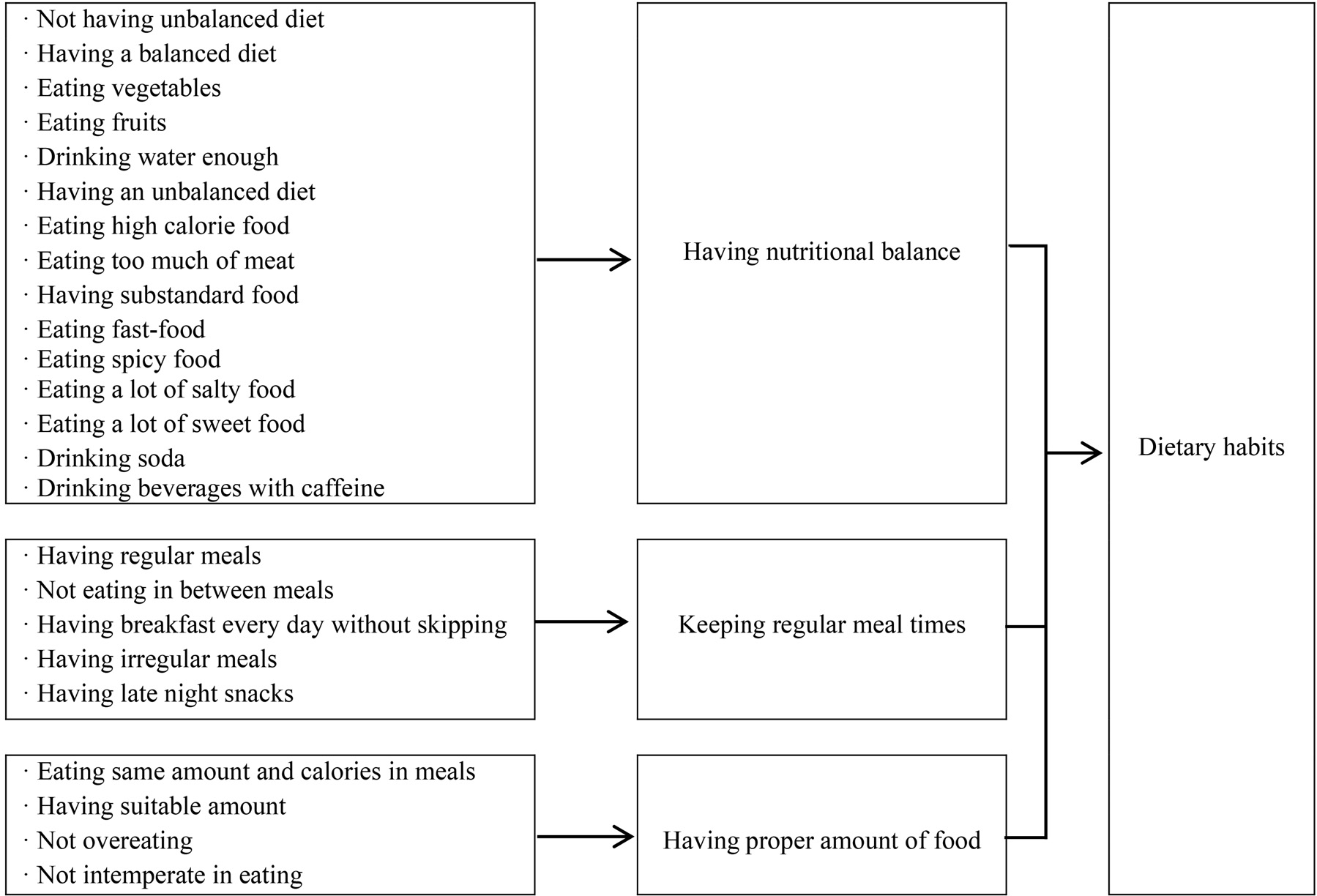Abstract
Background
Adolescence is the starting period for health behaviors that will affect their lives throughout adulthood. Unhealthy behaviors in Korean adolescents have increased compared to previous generations. To promote health behaviors in this group, a comprehensive measurement of Korean adolescents' health behaviors is necessary. Most previous studies have used revised instruments, which were developed in other cultures, but not tools developed to measure health behaviors based on the perspectives of Korean adolescents. Identifying the perception of health behavior among Korean adolescents is important for the future of health promotion. Therefore, this study was conducted to investigate Korean adolescents' perceptions of their health behaviors.
Methods
A qualitative study was conducted to attain a condensed and broad description of the health behaviors that adolescents perceived as health-promoting behaviors or risk behaviors. From October to December 2008, 61 Korean middle and high school students were interviewed on their perceptions of health behaviors. Data were analyzed using inductive qualitative content analysis.
Results
Korean adolescents reported health behaviors related to stress, mental health, sleep habits, dietary habits, weight control, physical activity, hygiene habits, safety, computer use, substance use, health screening and others.
Conclusions
The results provide socio-cultural characteristics about the perception of health behaviors among Korean adolescents and should contribute to guiding assessment of health behaviors in Korean adolescents and provide a reference for developing valuable health-promoting interventions based on these characteristics.
Go to : 
References
1. Gramkowski B, Kools S, Paul S, Boyer CB, Monasterio E, Robbins N. Health risk behavior of youth in foster care. J Child Adolesc Psychiatr Nurs. 2009; 22(2):77–85.

2. Kim YH. Korean adolescents' health risk behaviors and their relationships with the selected psychological constructs. J Adolesc Health. 2001; 29(4):298–306.

3. Shin YH. Development and psychometric evaluation of a scale to measure health behaviors of adolescents. J Korean Acad Nurs. 2010; 40(6):820–30.

4. Wainwright P, Thomas J, Jones M. Health promotion and the role of the school nurse: a systematic review. J Adv Nurs. 2000; 32(5):1083–91.

5. Statistics Korea. Summary of census population. Reston: Statistics Korea;2005. [Accessed April 22, 2010].http://kosis.kr/statisticsList/statisticsList_01List.jsp?vwcd=MT_ZTITLE&parmTabId=M_01_01#SubCont.
6. Kann L, Brener ND, Warren CW, Collins JL, Giovino GA. An assessment of the effect of data collection setting on the prevalence of health risk behaviors among adolescents. J Adolesc Health. 2002; 31(4):327–35.

7. Chen MY, James K, Wang EK. Comparison of health-promoting behavior between Taiwanese and American adolescents: a cross-sectional questionnaire survey. Int J Nurs Stud. 2007; 44(1):59–69.

8. Walker SN, Sechrist KR, Pender NJ. The Health-Promoting Lifestyle Profile: development and psychometric characteristics. Nurs Res. 1987; 36(2):76–81.
9. An JY, Tak YR. Health-risk behaviors and self-efficacy in elderly adolescents. J Korean Acad Community Health Nurs. 2006; 17(3):387–96.
10. Byun YS, Lee HY. A study on health risk behaviors in adolescents. J Korean Acad Fundam Nurs. 2005; 12(3):413–20.
11. Kim HS. A Study on the Relations of Health Promoting Behavior and Perceptions of Body-image in Middle School Students [Dissertation]. Seoul: Seoul National University;2006. Korean.
12. Seol YH. Comparison of Stress and Health Behavior between Children in the Broken Family and Those in the Normal Family [Dissertation]. Gwangju: Chonnam National University;2007. Korean.
13. Parvizy S, Nikbahkt A, Pournaghash Tehrani S, Shahrokhi S. Adolescents' perspectives on addiction: qualitative study. Nurs Health Sci. 2005; 7(3):192–8.

14. Marshall C, Rossman GB. Designing Qualitative Research. 5th ed. Thousand Oaks, CA:Sage Publications;2010.
15. Millstein SG, Petersen AC, Nightingale EO. Promoting the Health of Adolescents: New Directions for the Twenty-First Century. New York, NY:Oxford University Press;1993.
16. Shin YH. Development and psychometric evaluation of a scale to measure health behaviors of adolescents. J Korean Acad Nurs. 2010; 40(6):820–30.

17. Krippendorff K. Content Analysis: An Introduction to Its Methodology. 2nd ed. Thousand Oaks, CA:Sage Publications;2004.
20. Sandelowski M. Combining qualitative and quantitative sampling, data collection, and analysis techniques in mixed-method studies. Res Nurs Health. 2000; 23(3):246–55.

21. Gochman DS. Handbook of Health Behavior Research. New York, NY: Plenum Press;1997.
22. Kim SY. Human Growth and Development and Nursing of Adolescents. Paju: Soomoonsa;2004.
23. Eaton DK, Kann L, Kinchen S, Shanklin S, Flint KH, Hawkins J, et al. Centers for Disease Control and Prevention (CDC). Youth risk behavior surveillance – United States, 2011. MMWR Surveill Summ. 2012; 61(4):1–162.
24. Ko YK, Yoo IY, Kang KH, Lim JY, Kim MJ, Yoo HJ. Factors related to high-risk health behavior in middle school adolescents. J Korean Acad Child Health Nurs. 2006; 12(3):341–50.
25. Robinson JA. The health behavior selection process of young adolescents. J Sch Nurs. 2001; 17(3):148–56.

26. DuRant RH, Smith JA, Kreiter SR, Krowchuk DP. The relationship between early age of onset of initial substance use and engaging in multiple health risk behaviors among young adolescents. Arch Pediatr Adolesc Med. 1999; 153(3):286–91.

27. MacKenzie TD, Steiner JF, Davidson AJ, Marine WM, Judson FN. Tobacco use and other risk behaviors among adolescents in an STD clinic. Prev Med. 1998; 27(6):792–7.

28. Yang JK, Kim CK. Relationships among delinquent risk factors, protective factors and recidivism of juvenile delinquency. Korean J Youth Couns. 2002; 10(2):101–21.
29. Rosenfield M. Computer vision syndrome: a review of ocular causes and potential treatments. Ophthalmic Physiol Opt. 2011; 31(5):502–15.

Go to : 
Table 1.
Content analysis of health behaviors among Korean adolescents




 PDF
PDF ePub
ePub Citation
Citation Print
Print




 XML Download
XML Download